Carbon Emission Estimation of Assembled Composite Concrete Beams during Construction
Abstract
1. Introduction
2. Life Cycle Assessment Theory
3. Sources of Carbon Emissions in the Whole Construction Process of Prefabricated Components
3.1. Production Stage
3.2. Transportation Stage
3.3. Installation Stage
4. Calculation Model of Carbon Emissions
4.1. Production Stage
4.2. Transport Stage
4.3. Installation Stage
5. Case Study
5.1. Production Stage
5.2. Transport Stage
5.3. Installation Stage
6. Data Analysis
6.1. Carbon Emission Assessment in the Whole Construction Process of CG-2 Composite Beams
6.2. Carbon Emission Assessment of CG-2 Composite Beams under Three Different Types of Transportation Energy Consumption
7. Conclusions
Author Contributions
Funding
Institutional Review Board Statement
Informed Consent Statement
Data Availability Statement
Conflicts of Interest
References
- Ürge-Vorsatz, D.; Harvey, L.D.; Sevastianos, M.; Mark, D.L. Mitigating CO2 emissions from energy use in the world’s buildings. Build. Res. Inf. 2007, 35, 379–398. [Google Scholar] [CrossRef]
- Lang, S. Progress in energy-efficiency standards for residential buildings in China. Energy Build. 2004, 36, 1191–1196. [Google Scholar] [CrossRef]
- Amber, K.P.; Aslam, M.W.; Mahmood, A.; Anila, K.; Muhammad, Y.Y.; Bilal, A.; Chulam, Q.C.; Syed, K.H. Energy consumption forecasting for university sector buildings. Energies 2017, 10, 1579. [Google Scholar] [CrossRef]
- Wahid, F.; Kim, D.H. A prediction approach for demand analysis of energy consumption using k-nearest neighbor in residential buildings. Int. J. Smart Home 2016, 10, 97–108. [Google Scholar] [CrossRef]
- Chen, H.; Chen, W. Potential impact of shifting coal to gas and electricity for building sectors in 28 major northern cities of China. Appl. Energy 2019, 236, 1049–1061. [Google Scholar] [CrossRef]
- Huo, T.; Ren, H.; Zhang, X.; Cai, W.; Feng, W.; Zhou, N.; Wang, X. China’s energy consumption in the building sector: A statistical yearbook-energy balance sheet based splitting method. J. Clean. Prod. 2018, 185, 665–679. [Google Scholar] [CrossRef]
- Yang, L.; Yan, H.; Lam, J.C. Thermal comfort and building energy consumption implications—A review. Appl. Energy 2014, 115, 164–173. [Google Scholar] [CrossRef]
- Luna-Tintos, J.F.; Cobreros, C.; Herrera-Limones, R.; Lopez-Escamilla, A. Methodology comparative analysis in the Solar Decathlon competition: A proposal of housing model based on a prefabricated structural system. Sustainability 2020, 12, 1882. [Google Scholar] [CrossRef]
- Jun, X. The advantages and disadvantages of prefabricated building. Constr. Design Eng. 2018, 29, 30–33. [Google Scholar]
- Chang, Y.; Li, X.; Masanet, E.; Zhang, L.; Huang, Z.; Ries, R. Unlocking the green opportunity for prefabricated buildings and construction in China. Resour. Conserv. Recycl. 2018, 139, 259–261. [Google Scholar] [CrossRef]
- Navaratnam, S.; Ngo, T.; Gunawardena, T.; Henderson, D. Performance review of prefabricated building systems and future research in Australia. Buildings 2019, 9, 38. [Google Scholar] [CrossRef]
- Bonamente, E.; Merico, M.C.; Rinaldi, S.; Pignatta, G.; Pisello, A.L.; Cotana, F.; Nicolini, A. Environmental impact of industrial prefabricated buildings: Carbon and energy footprint analysis based on an LCA approach. Energy Procedia 2014, 61, 2841–2844. [Google Scholar] [CrossRef]
- Cao, X.; Li, X.; Zhu, Y.; Zhang, Z. A comparative study of environmental performance between prefabricated and traditional residential buildings in China. J. Clean. Prod. 2015, 109, 131–143. [Google Scholar] [CrossRef]
- Luna-Tintos, J.F.; Cobreros, C.; Lopez-Escamilla, A.; Herrera-Limones, R.; Torres-GarcIa, M. Methodology to Evaluate the Embodied Primary Energy and CO2 Production at Each Stage of the Life Cycle of Prefabricated Structural Systems: The Case of the Solar Decathlon Competition. Energies 2020, 13, 4311. [Google Scholar] [CrossRef]
- Jaillon, L.; Poon, C.S.; Chiang, Y.H. Quantifying the waste reduction potential of using prefabrication in building construction in Hong Kong. Waste Manag. 2008, 29, 309–320. [Google Scholar] [CrossRef] [PubMed]
- Wu, H.J.; Yuan, Z.W.; Zhang, L.; Bi, J. Life cycle energy consumption and CO2 emission of an office building in China. Int. J. Life Cycle Assess. 2012, 17, 105–118. [Google Scholar] [CrossRef]
- Liu, G.; Gu, T.; Xu, P.; Hong, J.; Shrestha, A.; Martek, I. A production line-based carbon emission assessment model for prefabricated components in China. J. Clean. Prod. 2019, 209, 30–39. [Google Scholar] [CrossRef]
- Seo, S.; Kim, J.; Yum, K.; McGregor, J. Embodied carbon of building products during their supply chains: Case study of aluminium window in Australia. Resour. Conserv. Recycl. 2015, 105, 160–166. [Google Scholar] [CrossRef]
- Kong, A.; Kang, H.; He, S.; Li, N.; Wang, W. Study on the carbon emissions in the whole construction process of prefabricated floor slab. Appl. Sci. 2020, 10, 2326. [Google Scholar] [CrossRef]
- Lopez-Escamilla, A.; Herrera-Limones, R.; Leon-Rodriguez, A.L.; Torres-GarcIa, M. Environmental Comfort as a Sustainable Strategy for Housing Integration: The AURA 1.0 Prototype for Social Housing. Appl. Sci. 2020, 10, 7734. [Google Scholar] [CrossRef]
- Aye, L.; Ngo, T.; Crawford, R.H.; Gammampila, R.; Mendis, P. Life cycle greenhouse gas emissions and energy analysis of prefabricated reusable building modules. Energy Build. 2012, 47, 159–168. [Google Scholar] [CrossRef]
- Xie, H.S.; Zhou, X.J.; Huang, Y.; Shang, Y.F. Research on the measurement of carbon emission from railway operation and evaluation of low-carbon effect. J. Railw. Eng. Soc. 2014, 31, 117–122. [Google Scholar]
- Zhang, Z.; Wang, B. Research on the life-cycle CO2 emission of China’s construction sector. Energy Build. 2016, 112, 244–255. [Google Scholar]
- Wang, S.; Fang, C.; Guan, X.; Pang, B.; Ma, H. Urbanisation, energy consumption, and carbon dioxide emissions in China: A panel data analysis of China’s provinces. Appl. Energy 2014, 136, 738–749. [Google Scholar]
- Atmaca, N. Life-cycle assessment of post-disaster temporary housing. Build. Res. Inf. 2017, 45, 524–538. [Google Scholar] [CrossRef]
- Qi, Y.; Zhang, Y.; Jiang, H.; Hou, H.; Li, J. Life cycle assessment in urban territories: A case study of Dalian city, China. Int. J. Life Cycle Assess. 2019, 24, 1194–1208. [Google Scholar]
- Benedek, K.; Zsuzsa, S. A visual method for detailed analysis of building life cycle assessment results. Appl. Mech. Mater. 2019, 887, 319–326. [Google Scholar] [CrossRef]
- ISO14040. Environmental Management—Life Cycle Assessment—Priniciples and Framework; International Standard Organization: Geneva, Switzerland, 1997. [Google Scholar]
- Zhang, X.; Wang, F. Life-cycle carbon emission assessment and permit allocation methods: A multi-region case study of China’s construction sector. Ecol. Indic. 2017, 72, 910–920. [Google Scholar] [CrossRef]
- Sandanayake, M.; Zhang, G.; Setunge, S. Environmental emissions at foundation construction stage of buildings-Two case studies. Build. Environ. 2016, 95, 189–198. [Google Scholar]
- Gao, Y.; Li, Z.; Zhang, H.; Yu, B.; Wang, J. A carbon emission analysis model for prefabricated construction based on LCA. J. Eng. Manag. 2018, 32, 30–34. [Google Scholar]
- Kumanayake, R.; Luo, H. Life cycle carbon emission assessment of a multi-purpose university building: A case study of Sri Lanka. Front. Eng. Manag. 2018, 5, 381–393. [Google Scholar]
- Hu, B.; Qiao, C.; Yuan, X.; Chen, W. Research Status of Carbon Emissions Accounting Methods for Industrial Buildings and Traditional Buildings. Build. Energy Effic. 2018, 46, 137–140. [Google Scholar]
- Peng, C. Calculation of a building’s life cycle carbon emissions based on Ecotect and building information modeling. J. Clean. Prod. 2016, 112, 453–465. [Google Scholar]
- Pandey, D.; Agrawal, M.; Pandey, J.S. Carbon footprint: Current methods of estimation. Environ. Monit. Assess. 2011, 178, 135–160. [Google Scholar]
- Song, M.; Guo, X.; Wu, K.; Wang, G. Driving effect analysis of energy-consumption carbon emissions in the Yangtze River Delta region. J. Clean. Prod. 2015, 103, 620–628. [Google Scholar]
- Gong, X.; Nie, Z.; Wang, Z.; Zuo, T. Research and development of Chinese LCA database and LCA software. Rare Met. 2006, 25, 101–104. [Google Scholar]

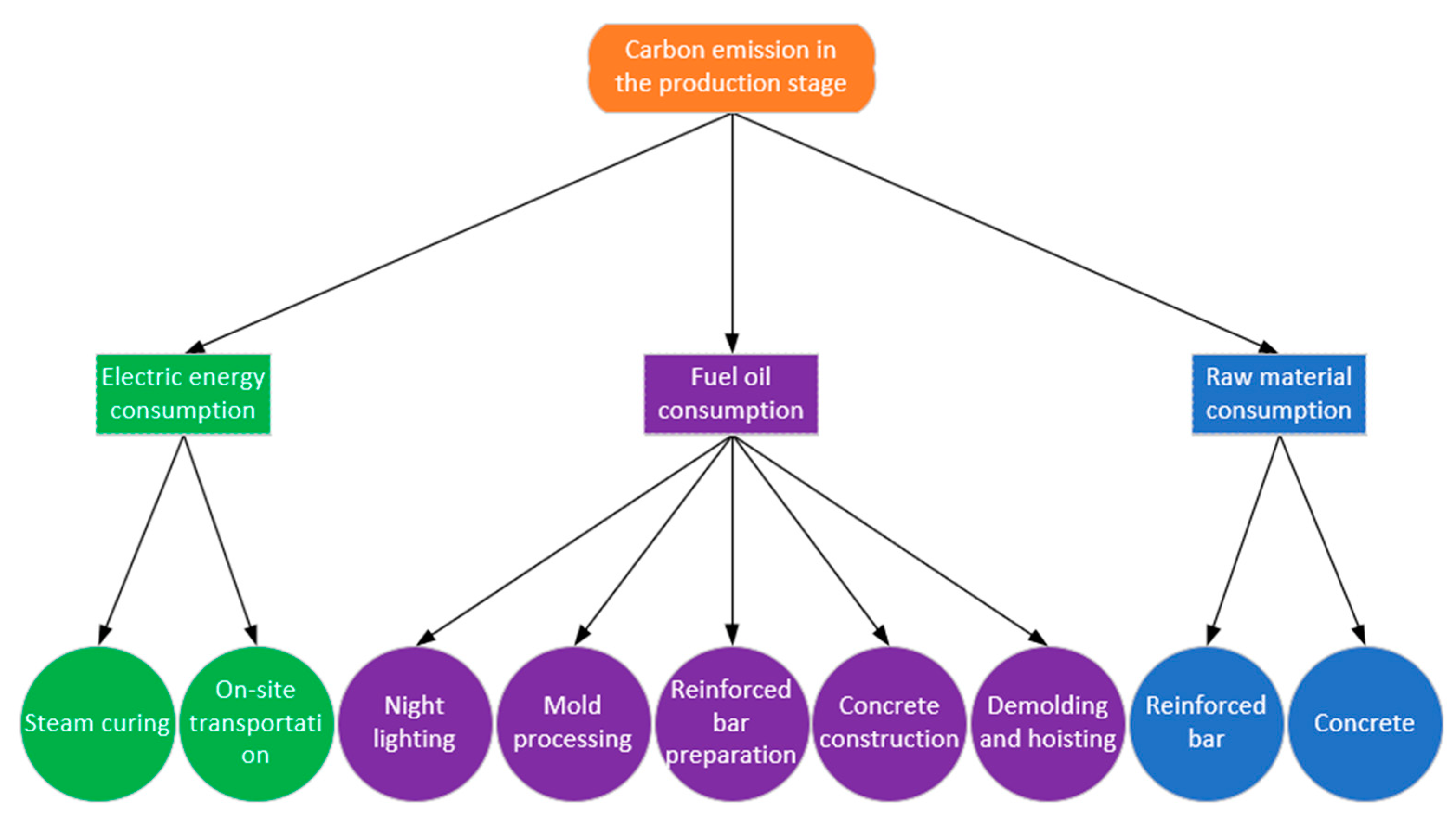
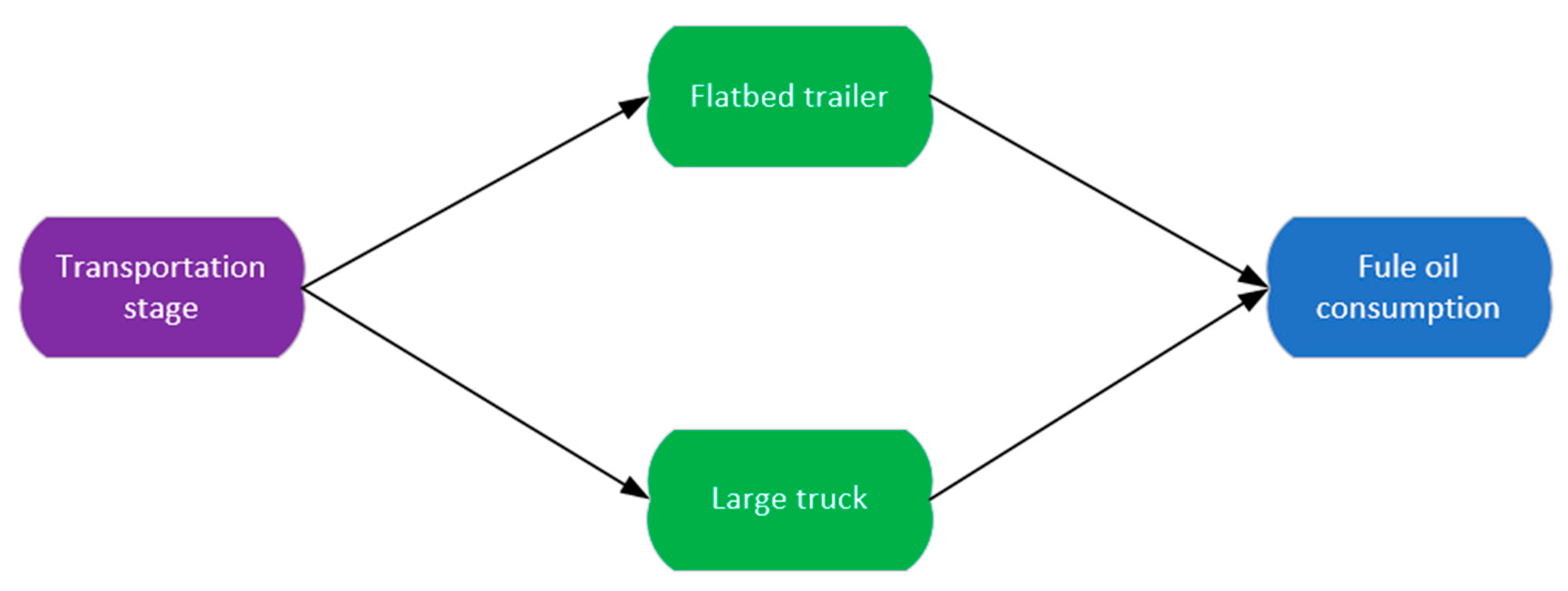
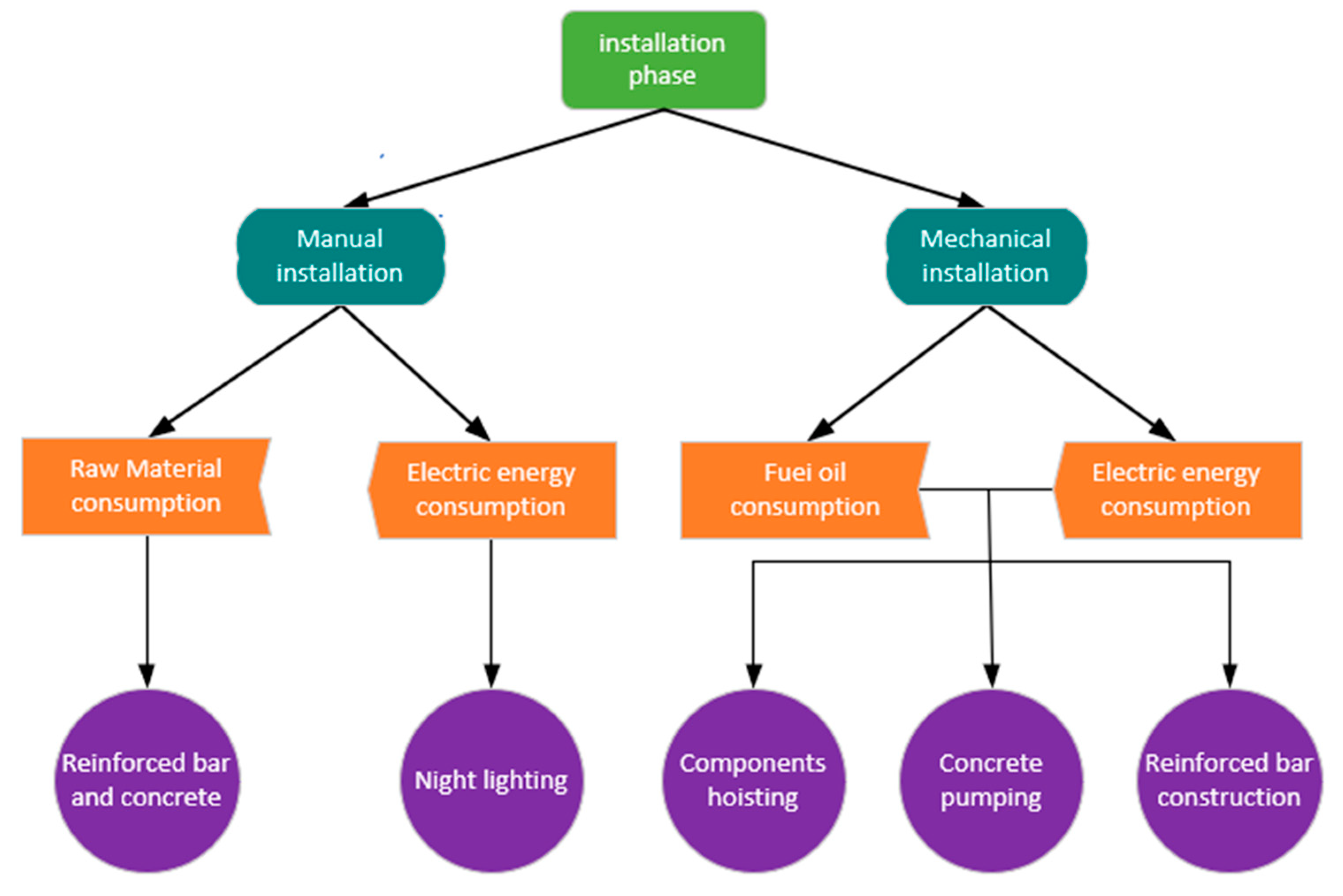
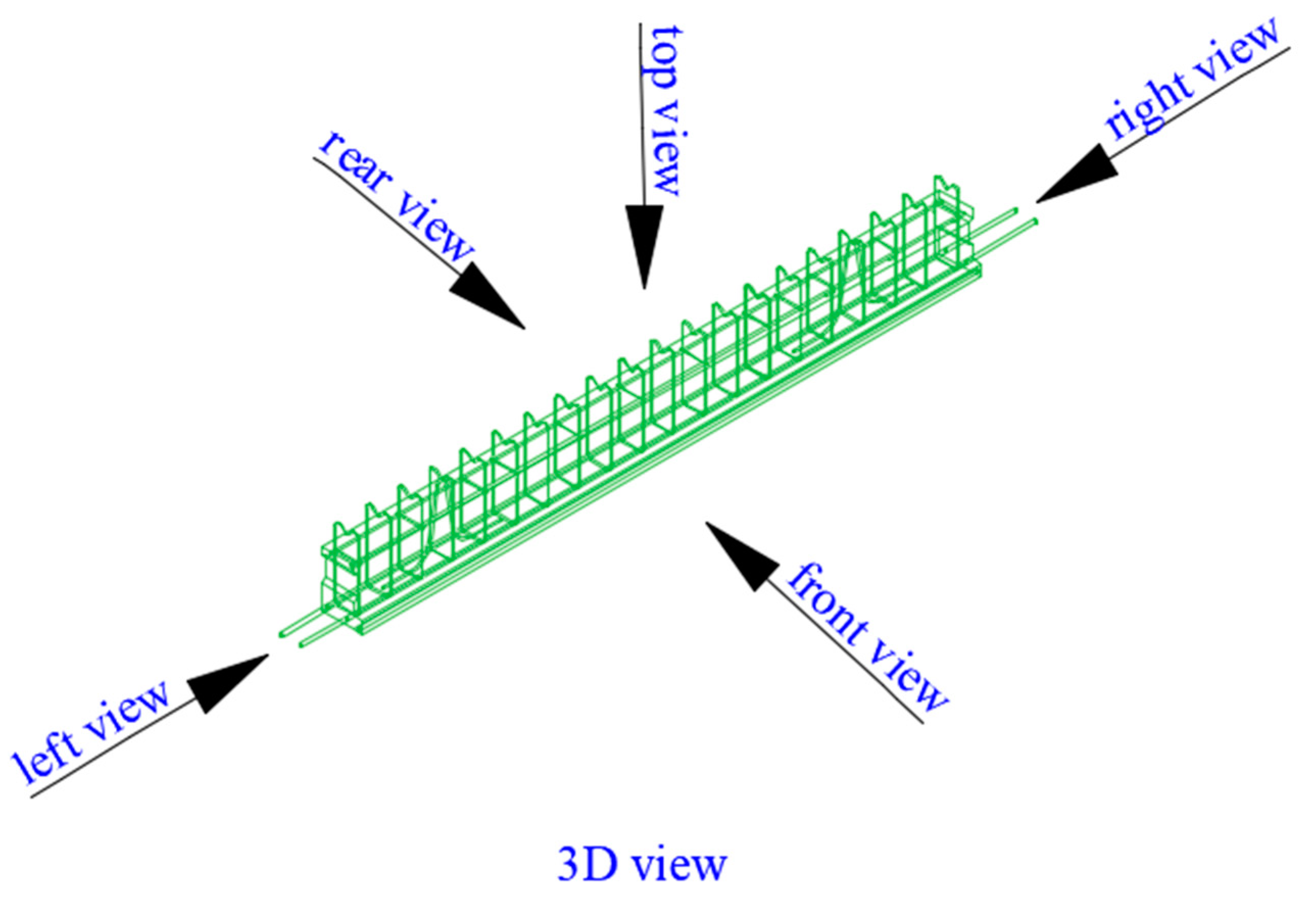

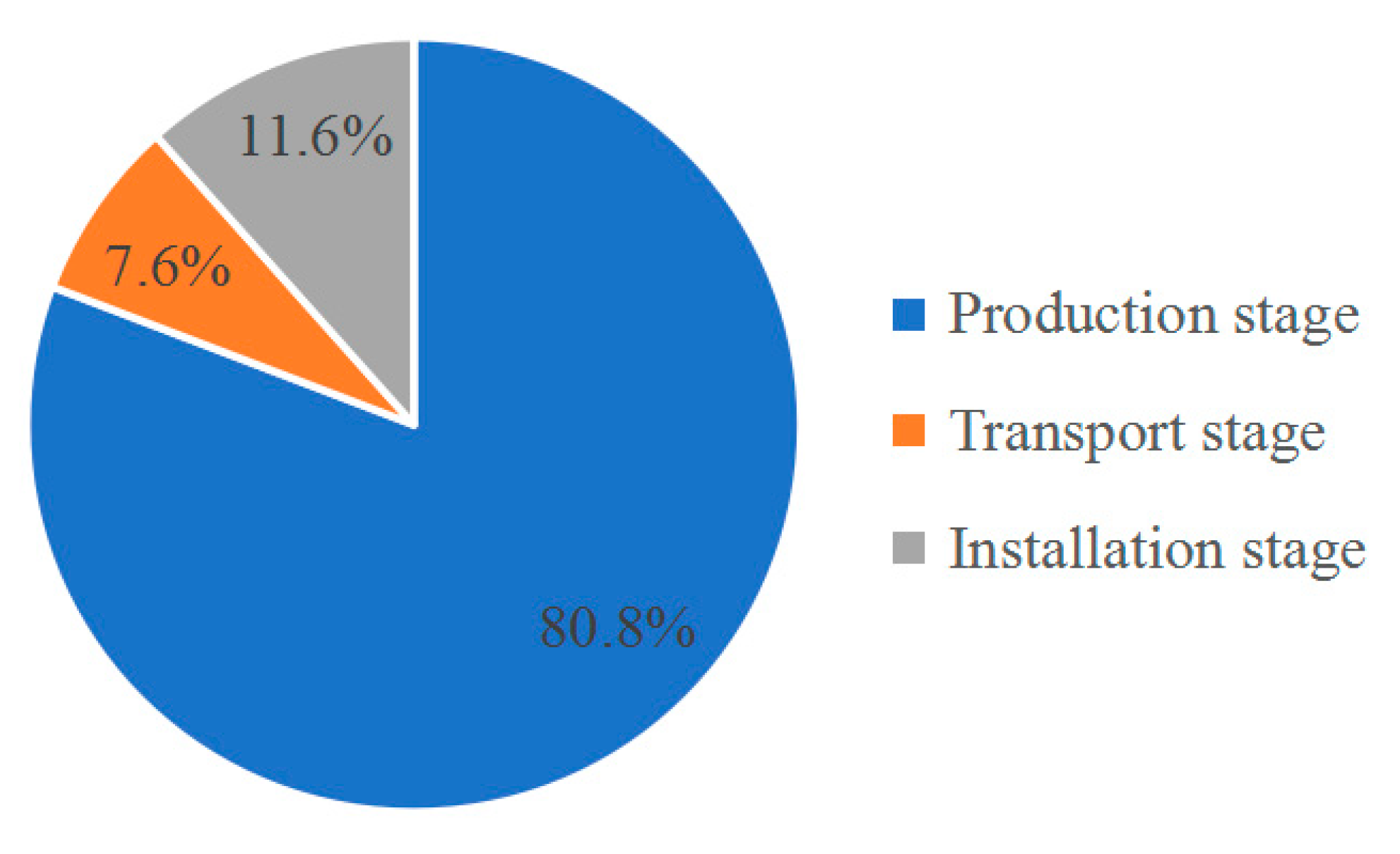
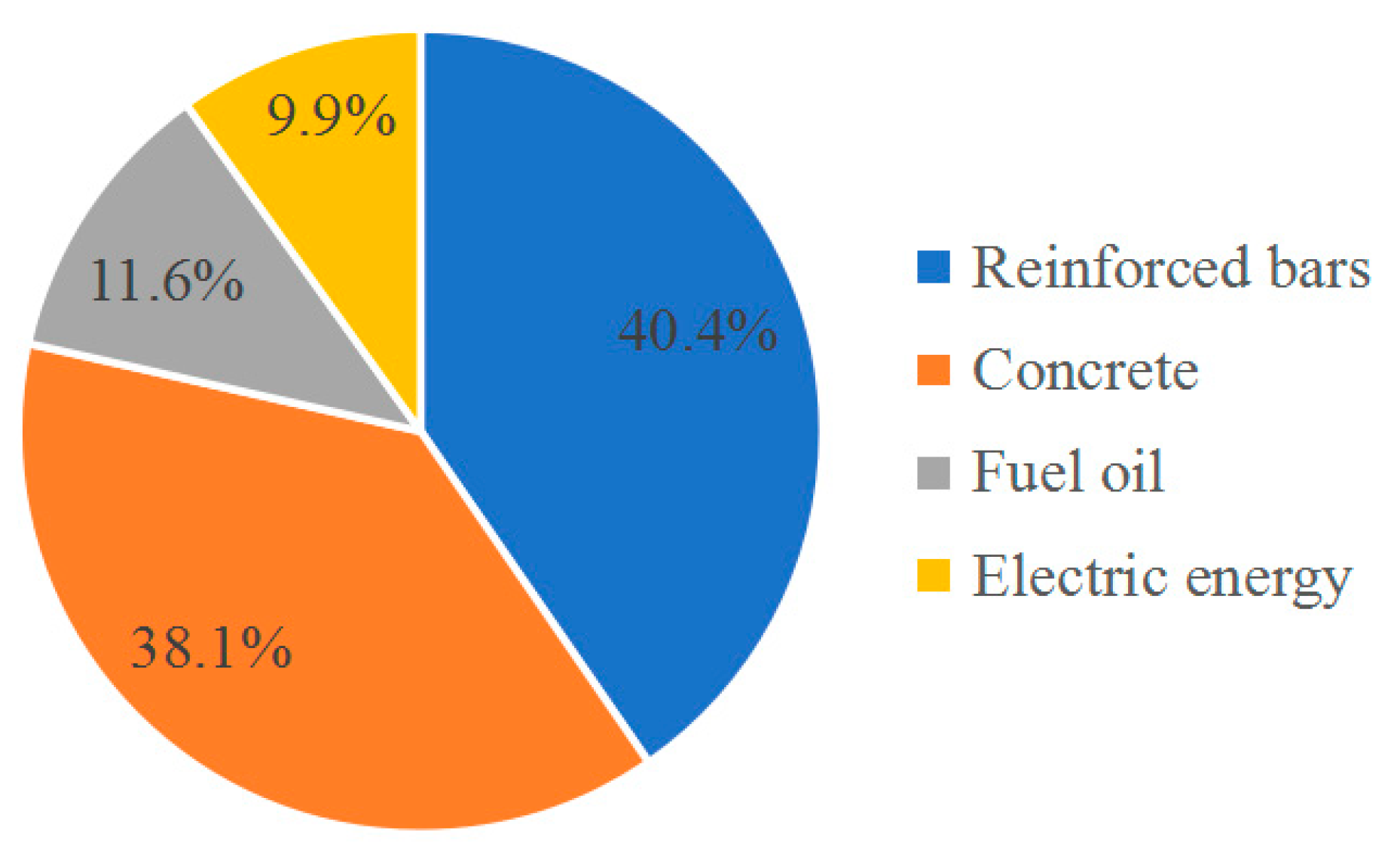

| Transportation Vehicles | Value/[kg CO2eq/(km.t)] |
|---|---|
| Medium Gasoline truck (load 2 t) | 0.1034 |
| Heavy Gasoline truck (load 10 t) | 0.1402 |
| Medium Diesel truck (load 8 t) | 0.1663 |
| Heavy Diesel truck (load 10 t) | 0.1772 |
| Electric truck | 0.0109 |
| Diameter | Amount | Size (mm) | Volume (m3) |
|---|---|---|---|
| Φ14 | 2 |  | 0.00125 |
| Φ12 | 2 |  | 0.00056 |
| Φ8 | 1 |  | 0.00012 |
| Φ8 | 13 |  | 0.00025 |
| Φ6 | 11 |  | 0.00029 |
| Φ6 | 9 |  | 0.00006 |
| Φ6 | 2 |  | 0.00005 |
| total | 40 | 0.00258 |
| Product Name | Density (kg/m3) | Volume (m3) | Mass (kg) |
|---|---|---|---|
| Hot-rolled reinforced bar | 7890 | 0.00258 | 20.356 |
| C30 concrete | 2360 | 0.156 | 368.16 |
| Reinforced concrete | 2449 | 0.15858 | 388.516 |
| Product Name | Consumption | Carbon Emission Coefficient | Carbon Emission (kg) |
|---|---|---|---|
| Hot-rolled reinforced bar | 305.34 kg | 2.617 kg CO2eq/kg | 799.07 |
| C30 concrete | 2.34 m3 | 321.3 kg CO2eq/m3 | 751.84 |
| Fuel oil | 70.5 L | 3.24 kg CO2eq/L | 228.49 |
| electric energy | 270.8 kwh | 0.723 kg CO2eq/kwh | 195.79 |
| Total | 1975.19 | ||
| Name | Value |
|---|---|
| CG-2 composite beam components | 15 |
| CG-2composite beam volume | 0.1586 m3 |
| CG-2composite beam density | 2450 kg/m3 |
| CG-2composite beam mass | 388.5 kg |
| One-time transportation distance | 100 km |
| One-time transportation components | 15 |
| One-time transportation mass | 5.8275 t |
| Transportation numbers | 1 |
| No-load coefficient of truck | 0.67 |
| Transportation Vehicle | Carbon Emission Coefficient /[kg CO2eq/(km.t)] | Carbon Emissions (kg) |
|---|---|---|
| Medium Diesel oil truck (load 8 t) | 0.1663 | 186.05 |
| Medium Gasoline truck (load 8 t) | 0.1034 | 115.68 |
| Electric truck (load 8 t) | 0.0109 | 12.24 |
| Total | 313.97 | |
| Energy Consumption | Consumption (kwh) | Carbon Emission Coefficient | Carbon Emissions (kg) |
|---|---|---|---|
| Electric energy | 392.4 | 0.723 kg CO2eq/kwh | 283.71 |
| Total | 283.71 | ||
Publisher’s Note: MDPI stays neutral with regard to jurisdictional claims in published maps and institutional affiliations. |
© 2021 by the authors. Licensee MDPI, Basel, Switzerland. This article is an open access article distributed under the terms and conditions of the Creative Commons Attribution (CC BY) license (http://creativecommons.org/licenses/by/4.0/).
Share and Cite
Xu, K.; Kang, H.; Wang, W.; Jiang, P.; Li, N. Carbon Emission Estimation of Assembled Composite Concrete Beams during Construction. Energies 2021, 14, 1810. https://doi.org/10.3390/en14071810
Xu K, Kang H, Wang W, Jiang P, Li N. Carbon Emission Estimation of Assembled Composite Concrete Beams during Construction. Energies. 2021; 14(7):1810. https://doi.org/10.3390/en14071810
Chicago/Turabian StyleXu, Kaitong, Haibo Kang, Wei Wang, Ping Jiang, and Na Li. 2021. "Carbon Emission Estimation of Assembled Composite Concrete Beams during Construction" Energies 14, no. 7: 1810. https://doi.org/10.3390/en14071810
APA StyleXu, K., Kang, H., Wang, W., Jiang, P., & Li, N. (2021). Carbon Emission Estimation of Assembled Composite Concrete Beams during Construction. Energies, 14(7), 1810. https://doi.org/10.3390/en14071810








